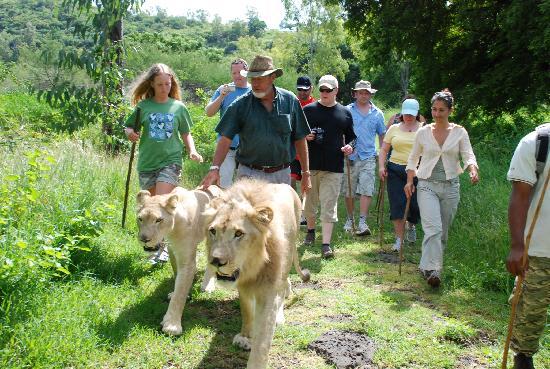Interaction - Walking with big cats

More and more, tourism operators give the opportunity to play with big cat cubs or to walk with “tamed” individuals as part of a supposed conservation programme. This way, lions, tigers, jaguars or pumas become the victims of another – often macabre – business which works mainly as a trick to tourists. Those activities are offered in several African States (South Africa, Zambia, Zimbabwe and Mauricio), in South America and also in some EU zoos.
Typically, it is claimed that fees related to those activities are intended to benefit the conservation of those species in the wild; however, rarely or never, the employed animals are then released. On the contrary, it has been discovered that very often, the moment animals grow and get used to live with human beings, they are sold to companies organising despicable canned hunting.
Some centres claim that this activity is part of a four-phase process, during which first young animals are taken care of, then placed into controlled pens with other animals, afterwards, moved to bigger pens where they can hunt by themselves and eventually released into the wild. Curiously, none of those projects had reached that fourth phase… In fact, not a single zoo into the world, including those with access to science and advance knowledge has succeeded in releasing big cats into the wild.
A recent scientific report, written by nine of the most world-renowned big cats and conservation biologists, rejects the conservationist side those centres claim to have, stating that: “Even under the best circumstances, the influence of lion breeding in captivity in dealing with the causes of this species decline in its natural habitat is very small. Any resource and effort would be much more effective if they were addressed to secure lions’ actual habitat and to mitigate their and their prey’s anthropogenic massacre… the reintroduction of captive lions contributes very little to solve those issues and distracts attention away from significant efforts to preserve lions on the spot”. The document concludes with: “… taking into account that no lion has been reintroduced in his natural habitat since those activities have first started in 1999, a period during which 100 wild founders have been successfully transferred, they cannot be considered as a model to adopt to deal with big cats”.
The first step to get animals used to human beings and mothers to be fertile again and procreate the soonest possible – to keep a constant provision of cubs – is to separate cubs from their mothers a few hours or days soon after their birth. This way, it is possible to force reproductive cycles and get up to 5 litters in 2 years. In those centres, endogamy is often practiced, as animals used to procreate are always the same, a practice which creates several health problems for the offspring.
For obvious reasons, it is impossible to reintroduce into the wild animals that have been got accustomed to the presence of humans beings, as they do not get scared of people and, once free, they would get close to villages, provoking conflicts which could eventually end up in attacks to livestock and to people as well. Likewise, the process of de-humanise those animals is long and complex; teaching them how to hunt and properly relate with other animals is extremely difficult. At the most, those animals could be kept in big pens, but as coexisting with several adult male is not possible, it is necessary to deal with their excess in some other way.
Some centres make profit on animals during all along their lives, including their deaths. The moment they separate cubs from mothers, they let visitors, upon payment of a fee, feed them with feeding bottles and play with them. During their adolescent phase, young animals are allowed to participate at “walks” and when they get their grown-up age, they are sold for canned hunting (even within the company itself if they organise it). And that is not it, as corpses of animals which are not used to stuff trophies for their butchers could be sent to Asia to be sold in pieces on the market for traditional medicine.
We should not forget that wild animals have not gone through the taming process with human beings, which has been going on for hundreds of generations. Thus, those animals have not lost their instincts. Since they are potentially dangerous animals, any reaction of defence or fear could result into serious attacks to people. Often, to reduce those damages (or those occurred during “play time”), big cats have their claws removed, – an extremely painful practice and with serious consequences for the animals (more info on declawing can be found here) – their canines sanded or pulled out and they might be given sedatives.
After being exposed to this reality, operators as Kuoni or Virgin Holidays, stopped taking their clients to centres where big cats walks are performed.
More information on this study: http://www.panthera.org/sites/default/files/HUNTER-2012-WalkingWithLions-ORYX.PDF
Foto: Trip Advisor
